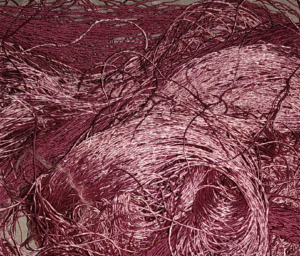Search the Blog
Latest Comments
Gummy or Not Gummy...
Well, that was probably a bit cryptic. So. Let me explain. About... silk.
As you probably know, most silk used in the Middle Ages was reeled, not spun - the long filaments from several cocoons wound off said cocoons together to get you a thread of silk. The more cocoons, the thicker your thread.
When the silkworm makes the cocoons, they're for its protection - so they are pretty hard. That's caused by sericin, or silk gum, which is more or less a protein-based glue sticking the filaments together and hardening them into a nice, protective shell. Hot water softens the sericin so the cocoons can be reeled off (it also kills the silkworm). The glue stays on, though, getting you... gummy silk, or raw silk.
This raw silk is stiff and can feel like a stiff nylon thread, very un-like the soft silk that we know today... because modern silk is usually completely de-gummed.
The thing about de-gummed silk? If you don't twist it, it is very fragile and prone to snagging. It's hard to handle altogether (though yes, very soft and shiny). Since talking to a conservator friend years ago who told me that usually, medieval silks have a much firmer structure than modern ones, I've been wondering about the use of gummy or partially gummy silk in history. The more recent research about the Albecund band is making me more and more convinced that gummy silk would be the solution to a few of the issues with weaving such a band.
One of the questions in that regard was - how does dyeing gummy silk work? Will it dye well? And will the dye be fast? (Side question - what happens if you de-gum it after dyeing?)
Well, I've gotten back two skeins that were test- dyed together, as in both mordanted and dyed together.

The gummy silk took on the colour much, much better... isn't that fascinating?
Comments 11
That's really interesting! And it probably explains the deep colours we see in medieval embroidery. And how they were able to do couching over padding with a relatively thin thread and still being able to force the gold threads into place and keep them there. How does this partly gummed silk compare to modern Chinese flat silk? That's my go-to silk for medieval projects as it produces embroidery with a slight wavey texture as seen in medieval embroidery.
I wrote an article a while ago where I came upon twisted medieval silk. This is from my article:
Lisa Monnas and Roberta Orsi Landini wrote on S-twisted silk threads: ´fourteenth-century velvets usually have Z-spun main ends…but from the late 1420s their [i.e. Italian velvets] main warp threads were generally S-twisted. In contrast Ottoman velvets of the late 15th and 16th centuries generally have Z-twisted main warp threads´ (Monnas 2012, 15); ‘the finest silk thread was used for the warp: strong shiny silk organzine, generally made up of 2 S-twisted ends’ (Orsi Landini 2017, 15-16).
Monnas, L. (2012) Renaissance velvets. London: V&A Publishing.
Orsi Landini, R. (2017) The velvets in the collection of the Costume Gallery in Florence / I velluti nella collezione della Galleria del costume di Firenze. Riggisberg and Florence: Edizioni Polistampa.
So even reeled silk seems to have been twisted - at least a bit.
I wrote an article a while ago where I came upon twisted medieval silk. Here is what I found out:
Lisa Monnas and Roberta Orsi Landini wrote on S-twisted silk threads: ´fourteenth-century velvets usually have Z-spun main ends…but from the late 1420s their [i.e. Italian velvets] main warp threads were generally S-twisted. In contrast Ottoman velvets of the late 15th and 16th centuries generally have Z-twisted main warp threads´ (Monnas 2012, 15); ‘the finest silk thread was used for the warp: strong shiny silk organzine, generally made up of 2 S-twisted ends’ (Orsi Landini 2017, 15-16).
Monnas, L. (2012) Renaissance velvets. London: V&A Publishing.
Orsi Landini, R. (2017) The velvets in the collection of the Costume Gallery in Florence / I velluti nella collezione della Galleria del costume di Firenze. Riggisberg and Florence: Edizioni Polistampa.
As someone who raised silk worms as a child and collected the silk from the cocoons, you can gather the silk without killing the pupa if the water is only warm, not steaming/near boiling like the various factories seem to use. I just took the silk until the pupa was clearly visible but still in a thin shell of silk and they all later hatched into viable moths which proceeded to spray eggs on every available surface.



